
Lumberjacks are mostly North American workers in the logging industry who perform the initial harvesting and transport of trees for ultimate processing into forest products. The term usually refers to loggers in the era when trees were felled using hand tools and dragged by oxen to rivers. The work was difficult, dangerous, intermittent, low-paying, and involved living in primitive conditions. However, the men built a traditional culture that celebrated strength, masculinity, confrontation with danger, and resistance to modernization.

Stanley is a city in Chippewa and Clark counties in the U.S. state of Wisconsin. The population was 3,608 at the 2010 census. Of this, 3,602 were in Chippewa County, and 6 in Clark County.
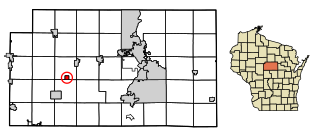
Fenwood is a village in Marathon County, Wisconsin, United States. It is part of the Wausau, Wisconsin Metropolitan Statistical Area. The population was 152 at the 2010 census.

A skidder is any type of heavy vehicle used in a logging operation for pulling cut trees out of a forest in a process called "skidding", in which the logs are transported from the cutting site to a landing. There they are loaded onto trucks, and sent to the mill. One exception is that in the early days of logging, when distances from the timberline to the mill were shorter, the landing stage was omitted altogether, and the "skidder" would have been used as the main road vehicle, in place of the trucks, railroad, or flume. Modern forms of skidders can pull trees with a cable/winch, just like the old steam donkeys, or with a hydraulic grapple either on boom or on the back of the frame (clambunk skidder).

The Chippewa River in Wisconsin flows approximately 183 miles (294 km) through west-central and northwestern Wisconsin. It was once navigable for approximately 50 miles (80 km) of its length, from the Mississippi River, by Durand, northeast to Eau Claire. Its catchment defines a portion of the northern boundary of the Driftless Area. The river is easily accessible for bikers and pleasure seekers via the Chippewa River State Trail which follows the river from Eau Claire to Durand.
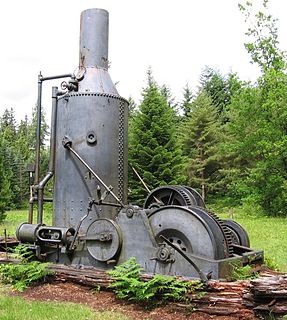
A steam donkey or donkey engine was a steam-powered winch once widely used in logging, mining, maritime, and other industrial applications.

Collier Memorial State Park is a state park in southern Oregon. The park is operated and maintained by the Oregon Parks and Recreation Department. It is located on U.S. Highway 97, approximately 30 miles (48 km) north of Klamath Falls and 105 miles (169 km) south of Bend. The park covers 146 acres (59 ha) along the Williamson River.
Disston is an unincorporated community in Lane County, Oregon, United States, southeast of Cottage Grove where Brice Creek and Layng Creek join to form the Row River. It is about a mile west of the Umpqua National Forest. Its post office opened in 1906 and ran until 1974. Cranston Jones—the first postmaster—was also one of the founders of the first sawmill in Disston and the name of the town came from the famous Disston saws.

The Lombard Steam Log Hauler, patented 21 May 1901, was the first successful commercial application of a continuous track for vehicle propulsion. The concept was later used for military tanks during World War I and for agricultural tractors and construction equipment following the war.

Hannibal is an unincorporated community located in Taylor County, Wisconsin, United States. Hannibal is located on Wisconsin Highway 73 and County Highway M north of Gilman, in the town of Cleveland. Today Hannibal is quiet, but once it was a bustling little economic hub at the junction of two logging railroads.
The Antrim Iron Company was an iron works that operated in Mancelona, Michigan from 1886 to 1945. The site of the iron works was south of Mancelona, between U.S. Route 131 and the railroad tracks.

Justus Smith Stearns was an American lumber baron and businessman. He was involved in many enterprises that involved commercial real estate development, sawmills, coal, farming, railroading, and electrical technology. He started his lumber pursuits as a teenager at his father's sawmills. From the business knowledge he learned from his father he became a lumber merchant in his twenties.
Porter's Mills, also called Porterville, was a logging boomtown in Eau Claire County, Wisconsin, United States, between Brunswick and Eau Claire, at 44° 46' 15" N 091° 34' 01" W. at an elevation of 771 feet.
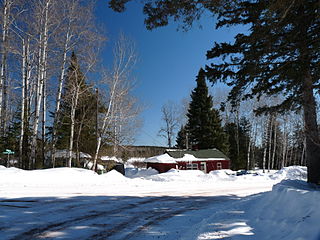
Morse is an unincorporated community located in the town of Gordon, Ashland County, Wisconsin, United States. Morse is located along the Bad River 7.5 miles (12.1 km) south-southeast of Mellen.
Shanagolden is an unincorporated community located in the town of Shanagolden, Ashland County, Wisconsin, United States. Shanagolden is located on the East Fork Chippewa River 10 miles (16 km) northwest of Butternut.

Grandfather Falls is the highest waterfall on the Wisconsin River. The total drop is 89 feet, spread out in a series of cascades over about one mile. The upper third of the falls and most of the flow, except in the spring, is diverted through a canal and a series of penstocks to feed hydroelectric generators. Grandfather Falls dam and power generating facility is owned and operated by Wisconsin Public Service Corporation.
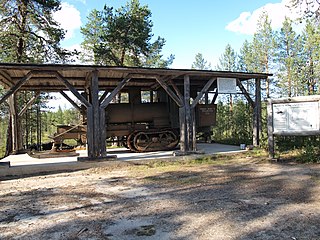
The Phoenix Manufacturing Company, later the Phoenix Steel Company, was one of Eau Claire, Wisconsin's oldest manufacturing firms. It manufactured equipment predominantly for the sawmill and logging equipment industries, which were vital to the establishment and growth of Eau Claire.
Adin Randall was a philanthropist, businessman, and politician in the Chippewa Valley of Wisconsin, who served as a first Treasurer of Eau Claire County, Wisconsin. He ran a ferry across the Chippewa, a planing mill, a sash and door factory, and invented the sheer boom to efficiently shunt logs into Half Moon Lake. He is regarded as one of the founders of the city. He donated the land for Randall Park, Lakeview Cemetery and the Eau Claire Area School District.
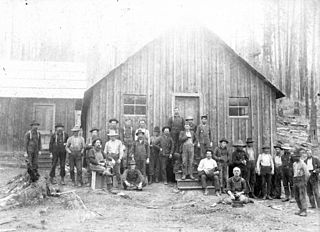
A logging camp is a transitory work site used in the logging industry. Before the second half of the 20th century, these camps were the primary place where lumberjacks would live and work to fell trees in a particular area. Many place names are legacies of old logging camps. Camps were often placed next to river tributaries so that the winter's log harvest could be floated to the lumbermills in the spring.
















